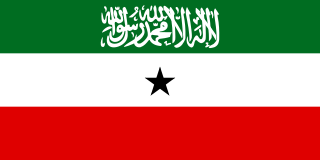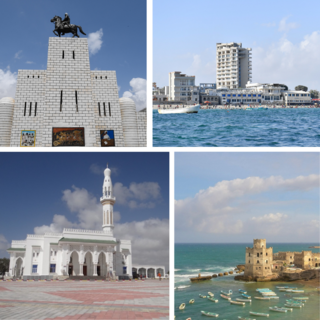Golharfo | |
|---|---|
Archaeological site | |
| Country | |
| Region | Sool |
| District | Las Anod |
| Time zone | UTC+3 (EAT) |
Golharfo is an archaeological site in the Sool region of Somaliland.
Golharfo | |
|---|---|
Archaeological site | |
| Country | |
| Region | Sool |
| District | Las Anod |
| Time zone | UTC+3 (EAT) |
Golharfo is an archaeological site in the Sool region of Somaliland.
Golharfo is situated in the Las Anod District, near Gubyaley and around 15–25 km east of Hudun. The site contains rock art of animals, weaponry and household items used by earlier civilisations. Additionally, Golharfo is one of the few sites with paintings of human figures. [1] [2]
Djibouti is a country in the Horn of Africa. It is bordered by Somaliland to the southeast, Eritrea and the Red Sea to the north and northwest, Ethiopia to the west and south, and the Gulf of Aden to the east.

Somalia, officially the Federal Republic of Somalia, is a country in the Horn of Africa. The country is bordered by Ethiopia to the west, Djibouti to the northwest, the Gulf of Aden to the north, the Indian Ocean to the east, and Kenya to the southwest. Somalia has the longest coastline on Africa's mainland. Its terrain consists mainly of plateaus, plains, and highlands. Hot conditions prevail year-round, with periodic monsoon winds and irregular rainfall. Somalia has an estimated population of around 15 million, of which over 2 million live in the capital and largest city Mogadishu, and has been described as Africa's most culturally homogeneous country. Around 85% of its residents are ethnic Somalis, who have historically inhabited the country's north. Ethnic minorities are largely concentrated in the south. The official languages of Somalia are Somali and Arabic. Most people in the country are Muslims, the majority of them Sunni.
Somalia, officially the Federal Republic of Somalia and formerly known as the Somali Democratic Republic, is a country located in the Horn of Africa. The country was an important centre for commerce with the rest of the ancient world, and according to most scholars, it is among the most probable locations of the fabled ancient Land of Punt. During the Middle Ages, several powerful Somali states and port towns dominated the regional trade, the Mogadishu Sultanate and Ajuran Sultanate both centered around the port town Mogadishu, but also the port towns of Barawe and Merca.

Somaliland, officially the Republic of Somaliland, is a de facto state in the Horn of Africa, considered by all states to be part of Somalia. Somaliland lies in the Horn of Africa, on the southern coast of the Gulf of Aden. It is bordered by Djibouti to the northwest, Ethiopia to the south and west, and the uncontested part of Somalia to the east. Its claimed territory has an area of 176,120 square kilometres (68,000 sq mi), with approximately 5.7 million residents as of 2021. The capital and largest city is Hargeisa. The government of Somaliland regards itself as the successor state to British Somaliland, which, as the briefly independent State of Somaliland, united in 1960 with the Trust Territory of Somaliland to form the Somali Republic.

Mogadishu, locally known as Xamar or Hamar, is the capital and most populous city of Somalia. The city has served as an important port connecting with traders all round the Indian Ocean for millennia and has an estimated population of 2,388,000 (2021). Mogadishu is located in the coastal Banadir region on the Indian Ocean, which unlike other Somali regions, is considered a municipality rather than a maamul goboleed.

The Horn of Africa (HoA), also known as the Somali Peninsula, is a large peninsula of East Africa. Located on the easternmost part of the African mainland, it is the fourth largest peninsula in the world. It lies along the southern boundary of the Red Sea and extends hundreds of kilometres into the Guardafui Channel, Gulf of Aden, and Indian Ocean.

East Africa, Eastern Africa, or East of Africa is the eastern subregion of the African continent. In the United Nations Statistics Division scheme of geographic regions, 19* territories make up Eastern Africa:

Somali is an Afroasiatic language belonging to the Cushitic branch. It is spoken as a mother tongue by Somalis in Greater Somalia and the Somali diaspora. Somali is an official language of Somalia, Somaliland, and Ethiopia, and a national language in Djibouti as well as in northeastern Kenya. The Somali language is written officially with the Latin alphabet although the Arabic alphabet and several Somali scripts like Osmanya and the Borama script are informally used.

Las Khorey is a historic coastal town in the Sanaag region of Somaliland.

The Somalis are an East Cushitic ethnic group native to the Horn of Africa who share a common ancestry, culture and history. The Somali language is the shared mother tongue of ethnic Somalis, which is part of the Cushitic branch of the Afroasiatic language family, and are predominately Sunni Muslim. They form one of the largest ethnic groups on the African continent, and cover one of the most expansive landmasses by a single ethnic group in Africa.
The Osmanya script, also known as Far Soomaali and, in Arabic, as al-kitābah al-ʿuthmānīyah, is a writing script created to transcribe the Somali language. It was invented between 1920 and 1922 by Osman Yusuf Kenadid, the son of Sultan Yusuf Ali Kenadid and brother of Sultan Ali Yusuf Kenadid of the Sultanate of Hobyo.

The history of Somaliland, a country in the eastern Horn of Africa bordered by the Gulf of Aden, and the East African land mass, begins with human habitation tens of thousands of years ago. It includes the civilizations of Punt, the Ottomans, and colonial influences from Europe and the Middle East.

The Ajuran Empire, also spelled Ajuuraan Empire, and often simply as Ajuran, was a Somali empire in the Middle Ages in the Horn of Africa that dominated the trade in the northern Indian ocean. They belonged to the Somali Muslim sultanate that ruled over large parts of the Horn of Africa in the Middle Ages. Through a strong centralized administration and an aggressive military stance towards invaders, the Ajuran Empire successfully resisted an Oromo invasion from the west and a Portuguese incursion from the east during the Gaal Madow and the Ajuran-Portuguese wars. Trading routes dating from the ancient and early medieval periods of Somali maritime enterprise were strengthened or re-established, and foreign trade and commerce in the coastal provinces flourished with ships sailing to and coming from many kingdoms and empires in East Asia, South Asia, Europe, the Near East, North Africa and East Africa.

Djibouti, officially the Republic of Djibouti, is a country located in the Horn of Africa. It is bordered by Somalia in the south, Ethiopia in the southwest, Eritrea in the north, and the Red Sea and the Gulf of Aden in the east. Across the Gulf of Aden is Yemen. The country has a total area of 23,200 km2 (8,958 sq mi).

El Ayo, also known as El Ayum, is a coastal town in the eastern Sanaag region of Somaliland, near the border with Somalia. There is a base of the Puntland Maritime Police Force, which is effectively controlled by Puntland.

Somali architecture is the engineering and designing of multiple different construction types such as stone cities, castles, citadels, fortresses, mosques, temples, aqueducts, lighthouses, towers and tombs during the ancient, medieval and early modern periods in Somalia and other regions inhabited by Somalis, as well as the fusion of Somalo-Islamic architecture with Western designs in contemporary times.

Somali nationalism is centered on the notion that the Somali people share a common language, religion, culture and ethnicity, and as such constitute a nation unto themselves. The ideology's earliest manifestations in the medieval era are traced to the Adalites whilst in the contemporary era its often traced back to SYL or in present-day Somaliland, the first Somali nationalist political organization to be formed was the Somali National League (SNL), established in 1935 in the former British Somaliland protectorate. In the country's northeastern, central and southern regions, the similarly-oriented Somali Youth Club (SYC) was founded in 1943 in Italian Somaliland, just prior to the trusteeship period. The SYC was later renamed the Somali Youth League (SYL) in 1947. It became the most influential political party in the early years of post-independence Somalia.
Encyclopedias from ca. 1900 note that ancient tombs, pyramidal structures, ruined towns, and stone walls found in Somalia, such as the Wargaade Wall, are evidence of an old civilization in the Somali peninsula that predates Islam.
Karinhegane is an archaeological site in the eastern Sanaag region of Somaliland. It contains some unique polychrome rock art.

The COVID-19 pandemic was confirmed to have reached Somaliland in March 2020. As of 16 August 2021, there are 4703 cases and 319 deaths. 68206 tests have been conducted.